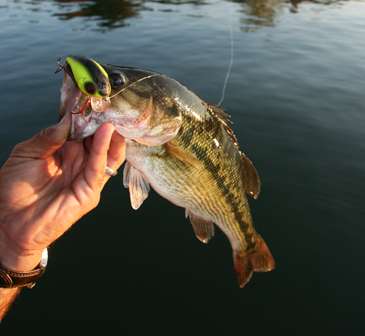
Childhood memories often influence adult decisions, and for Bassmaster Elite Series pro Michael Iaconelli, summer vacations yielded underwater perspectives that tell him how to wake up the dock bass.
Noting that his history of wakebaiting goes back to the late 1980s, Iaconelli said, “As a kid, I grew up on a lake in the Poconos, and, when I wasn’t fishing, I was swimming off the dock. Any time I was swimming around the dock and I’d look up, I’d see bluegill around the foam of those floating docks.
“Whether it’s bluegill, shad spawning around the docks or perch around the docks, that’s a killer pattern. If you look at the shape and profile of those fish, a wakebait is a perfect imitator.”
A couple of decades ago, Ike found few wakebait options. Anglers had some basic egg-shaped baits like a Mann’s Minus-1 and long, minnow-style lures like the Cotton Cordell Redfin. Today’s selection has grown exponentially, but that same unique action is what makes the magic happen.
“They do something in the water that no other bait does — they’re true subsurface baits,” Iaconelli said. “That’s what makes that bait shine. It’s not a bait that sinks; it’s not a true floating topwater. It’s an in-between bait. Some guys are afraid to throw treble hook lures around the docks, but your hook-up ratio is about 90 percent.”
Iaconelli prefers the Laser Lure SSD 0-1 for imitating bluegill or perch and Redfins for lanky baitfish like shad. The longer wakebaits, he said, are great for simulating the highly enticing lone baitfish scenario.
“If you’ve ever seen a lost shad swimming around all by itself, he makes a distinct V-wake at the surface,” Iaconelli explained. “He’s not doing the walk-the-dog motion, and he’s not spitting water. He’s just wandering around out there, looking for the school. That’s the one bass will target, and that’s one of the things a wakebait imitates.”
Docks of simple design certainly merit attention, but Iaconelli said he’s always looking for a structure that stands out from its neighbors. Example: In a row of uniform docks, one with a Jet Ski platform may hold more opportunity because of its unique element. In any case, Ike likes to wake for total coverage.
Keeping his boat about 30 to 40 feet out from a dock, he’ll make his first cast as far back to the near side as possible. As he trolls forward, the cast works parallel to that side. Cast number two passes the dock’s face, and the third shot borders the far side. Simple and efficient, the formula gives any hungry fish a good look.
“I like to fish all the edges, and, for me, three casts can cover a dock,” Iaconelli explained. “Some docks are more complex, but in general, it’s a great way to do that. You can cover a lot of water with a wakebait.”
Essential to the retrieve is keeping that bait in a subsurface position to create the enticing V-wake. Iaconelli said the proper presentation depends on floating line that won’t pull the bait downward. He’ll occasionally go with 40-pound SpiderWire braid around heavy cover, but for most dock applications, 15-pound Berkley Trilene Sensation does the job.
Waking around docks may arouse bass attention in all but the depths of winter, but Ike finds his wakebait tendencies overlap those of traditional topwater fishing. “Wakebaits are at their best when the water temperature gets up around spawning temperature, which is in the high ’50s. When I look at that temperature gauge and it’s 58 degrees or higher, that’s when I really start to think about wakebaits.”
Primetime, he said comes during postspawn. Fish leave the beds, some of the males are still guarding fry, females are filling their sagging bellies and all are moving toward their summer patterns.
As with any technique, wakebait color preference comes down to a match-the-hatch deal. Whatever the cosmetics, Iaconelli said his motivation to throw a wakebait traces way back to those summer swims.
“Wakebaits are probably one of the most underrated styles of hardbaits,” he said. “But if you think about what they do, it’s very natural.”





